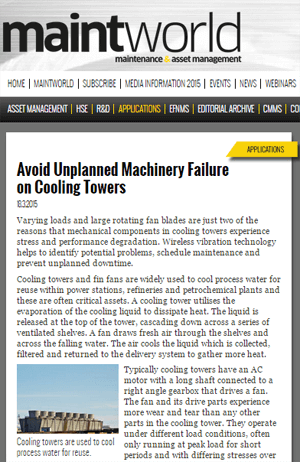Cooling tower technology used in many industrial processes dates its history back to the 19th century:
Cooling towers originated out of the development in the 19th century of condensers for use with the steam engine.[2] Condensers use relatively cool water, via various means, to condense the steam coming out of the pistons or turbines. This reduces the back pressure, which in turn reduces the steam consumption, and thus the fuel consumption, while at the same time increasing power and recycling boiler-water.[3]
Industrial cooling towers can be used to remove heat from various sources such as machinery or heated process material. The primary use of large, industrial cooling towers is to remove the heat absorbed in the circulating cooling water systems used in power plants, petroleum refineries, petrochemical plants, natural gas processing plants, food processing plants, semi-conductor plants, and for other industrial facilities such as in condensers of distillation columns, for cooling liquid in crystallization, etc.[9]
 Given their importance in heat removal, equipment failures in cooling towers lead to unplanned downtime. In a MaintWorld article, Avoid Unplanned Machinery Failure on Cooling Towers, Emerson’s Cranford Johnstone shares ways to avoid equipment issues from leading to downtime.
Given their importance in heat removal, equipment failures in cooling towers lead to unplanned downtime. In a MaintWorld article, Avoid Unplanned Machinery Failure on Cooling Towers, Emerson’s Cranford Johnstone shares ways to avoid equipment issues from leading to downtime.
Cranford opens:
Varying loads and large rotating fan blades are just two of the reasons that mechanical components in cooling towers experience stress and performance degradation. Wireless vibration technology helps to identify potential problems, schedule maintenance and prevent unplanned downtime.
He describes the mechanical equipment:
Typically cooling towers have an AC motor with a long shaft connected to a right angle gearbox that drives a fan. The fan and its drive parts experience more wear and tear than any other parts in the cooling tower. They operate under different load conditions, often only running at peak load for short periods and with differing stresses over a prolonged period. Because of this, the mechanical components can develop degraded performance, which leads to failure. Also, as with any rotating equipment, bearing and gear failures, misaligned drive shafts, and excessive vibration are common.
Access to this equipment while cooling towers are operational is typically not possible by maintenance personnel which makes collecting health information not possible. This information is critical when the unit has been in operation over time, and:
This limits the usable information on the entire machine and does not provide an accurate picture of equipment condition. Having limited diagnostic data makes root cause analysis difficult and incomplete data makes it hard to plan maintenance, especially when you have to take into account production schedules, budgeting, approval and ordering of spare parts.
Wireless vibration monitors can provide this missing information. These devices provide:
…vibration levels on a continuous basis, thereby removing the opportunity for problems to go unnoticed between periodic checks. This information can be historicised and made available to the maintenance department as well as operators in the control room.
Read the article to see how these devices can be part of a continuous machinery health information system and open up opportunity to monitor essential assets where wiring is too difficult or expensive to install. Crandall closes with a case study from a Portuguese petrochemical manufacturer which now has greater visibility to the health of the equipment in their cooling towers.
You can connect and interact with other reliability experts in the Reliability & Maintenance group in the Emerson Exchange 365 community.





